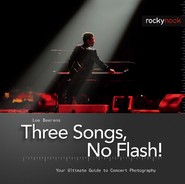Not every person in the music and concert promotion industry is important to you as a photographer. It's therefore good to know who's who in the household of an artist. Let's start at the top of the ladder with the artist himself.
The artist, in an artistic and creative way, is the absolute boss. If you are in close contact with the artist, anything can be arranged for you. His wish is everyone's command.
The manager has more or less the same status as the artist. His responsibility concerns the exploitation of the artist—from strategy to performance, recording contracts, concerts, finance, tickets, merchandising, food and beverage turnover, you name it. A good contact with the manager can give you unlimited access.
The tour manager works independently as an assistant to the manager and is in charge of all logistical matters on tour, including transportation, hotels, staging, and catering. He may give you permission to take photos, or, more often, recommend you to the manager who makes the final decision. The stage manager is responsible for everything up and around the stage—sound, lighting, visuals, rehearsals, sound checks, barriers, and security. He cannot give you permission to take photos. Please bear in mind that when you are promised something by an artist, his or her decision may be overruled by the manager or tour manager; most of the time for security reasons. The artist isn't always aware of the local situation and regulations. The manager and tour manager carry that responsibility, and they may decide against your presence. You don't want to be in the wrong, so always double-check with them. There is little room for negotiating with these people. Yes is yes, most of the time, and no is always no. If you get a "yes" from any of the aforementioned people, always stick to the general rules and etiquette. Even when you know the artist personally, never just walk right across the stage or stand in front of the artist during the performance.
Record company representatives often look after the applications and secure the photo passes at a concert. When the concert tour coincides with the release and promotion of a new album, direct your application to the press officer of the record company involved. He or she will put the list of photographers together and ask the manager for agreement. On the evening of the concert, he or she will guide you front stage where you can take photos, most of the time for the duration of three songs. After that, the press officer will guide you out of the photo pit and out of the hall. It's best to listen and do whatever the press officer tells you to do, because you'll be dealing with the same person the next time you need a photo pass.
If you are interested in concert photography, I don't recommend starting out with well-known artists in huge venues. Get some experience first with smaller bands that play in local clubs. There won't be a spectacular light show, but you can learn a lot about capturing the intentions and expressions of the musicians. Study their behavior and realize that you aren't just making a photo of a person with an instrument in his hand. Find out how to get the best shot of a guitarist, horn player, or drummer. Look for the right moment to press the shutter. In a later chapter, you will read more about photographing various musicians and their instruments.
Another advantage of shooting smaller bands is that you can take photos for as long as you want. You are not restricted to three songs, which is the general rule at big concerts of international bands. For an experienced photographer, three songs should be enough to get some decent shots for your assignment. Flash is strictly forbidden. Use your flash once, and security will remove you from the photo pit immediately. Security will also remind you about the three-song rule (or two or four, whatever the deal was) and direct you to the exit of the hall when your time is up.
When security tells you to go, go! Keep your camera down next to your body and don't take any more photos as you walk out of the photo pit. Security is criticized when photographers try to do this, so they never allow it. You don't want a punch or push from them. Remember, it's a small world, and you are bound to meet them again at the next concert. You want to have a good reputation with security as someone who sticks to the rules. It may very well work in your favor in other situations. You should always remember that there is a hierarchy at a concert, and you, as photographer, are the lowest in rank. Let's take a look at who is more important than you at a concert.


